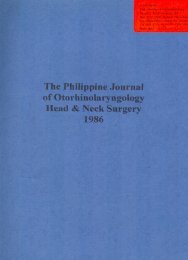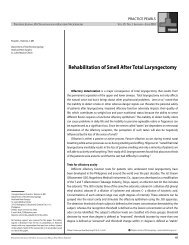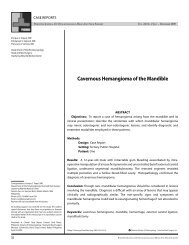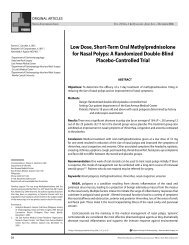You also want an ePaper? Increase the reach of your titles
YUMPU automatically turns print PDFs into web optimized ePapers that Google loves.
" to be packed with one type of packing was done on a mean age was 26.3 years. They were equally distributed<br />
stratified random manner. The patients were numbered as to sex. Basically, all patients underwent operations in<br />
consecutively, and then those who belonged to the odd- the area of the middle meatus plus variations which also<br />
numbered group had their left nasal cavity packed with involved bilateral, symmetrical disruption of nasal tisthe<br />
finger-cot type and their fight nasal cavity with sues (see Table 1). Of the 32 patients, five were not<br />
medium-strip gauze. Those who belonged to the even- anesthesized equally on both sides. On insertion of the<br />
numbered group had their right nasal cavity packed with nasal packs (see Table 2), 15 patients complained of<br />
finger-cot and their left nasal cavity with medium-strip, greater sensation of pain on the medium-strip side and<br />
In each patient, the medium-strip gauze was impreg- only 4 on the finger-cot. The rest claimed that there was<br />
hated with oxytetracycline/polymixin B ointment and no difference. Post-operative bleeding was controlled<br />
the finger-cot externally coated with the same, but the in all patients although 5 patients had minimal transient<br />
medium-strip gauze within the finger-cot extemally posteriorleak from the finger-cotside. Regarding probcoated<br />
with the same, but the medium-strip gauze within lems encountered on insertion of the nasal packs, the<br />
the finger-cot was only dampened with sterile water so surgeons pointed out that extra time was needed for the<br />
as to facilitate packing. (See appendix A.) proper insertion of the finger-cot type in 10 instances.<br />
After the procedure, the patients were sent home At home (see Table 3), 2 patients experienced more<br />
with oral medications consisting of an antibiotic* pain on the medium-strip side. Another 2 patients had<br />
(bacampicinin-PENGLOBE 400 mg BID x 10 days) minimal bleeding leak anteriorly, one for each type of<br />
and analgesic-decongestant (acetaminophen- pheny- packing. Minor complaints like clicking sound on<br />
lpropanolamine 325/18 mg - 650/36 mg TID x 5 days) swallowing and excessive rhinorrhea on the finger-cot<br />
drugs. They were followed up after 3 days for removal side were volunteered by 2 patients respectively. Four<br />
of packs. The finger-cot was first decompressed by patients came back before the scheduled follow-up day<br />
removing the inner dressing from the cot and then re- due to protrusion of the medium-strip gauze into the<br />
moving the cot from the nose. This was followed by oropharynx. The dangling portions were cut transortaking<br />
out the medium-strip gauze as gently as possible, ally, and the patients were sent home subsequently.<br />
Specimens from all nasal packing materials (two from<br />
the finger-cot type--t hat is, one from the outer surface On the 3rd post-operative day, the packs were<br />
and another from the non-medicated inner dressing) removed carefully. Twenty-three (23)patients claimed<br />
were collected and sent to the laboratory for microbiol- that the removal of the medium-strip gauze was more<br />
ogic processing.** painful than that of the finger-cot. Nine (9) felt no<br />
difference between the 2 methods of packing. None<br />
Evaluation of the two methods of packing was singled out the finger-cot as more painful. As to the<br />
conducted through subjective responses from the pa- appearance of the nasal mucosa (see Table 4), there was<br />
tients, objective assessments made by the surgeons, and no portion (i.e., inferior turbinate, septum, middle meatechnical<br />
data provided by microbiologic studies. De- tus and turbinate) in the nasal cavity that was found to<br />
tailed evaluation sheets were provided so as to standard- be abraded in the finger-cot side but smooth in the<br />
ize recording and facilitate analysis of data (see Appen- medium-strip side. Nearly all portions (97% of inferior<br />
dix B). Statistical testing was done using non-par- turbinate, middleturbinate and meatus,72%ofseptum)<br />
ametric methods whenever required, of the nasal cavity on the medium strip side were<br />
abraded. In contrast, to the finger-cot side generally had<br />
smooth mucosa (only 44% of inferior turbinate and 16%<br />
RESULTS<br />
of septum, middle turbinate and meatus were abraded).<br />
Recurrence of bleeding in variable degree was noted in<br />
A total of 32 patients was included in the study with all of the medium-strip side (see Tables 5 and 6). A1-<br />
age distribution ranging from 16 to 40 years old. The though 13 of these cases resolved spontaneously after 5<br />
minutes, 16 required application of 1% ephedrine sul-<br />
....... fate-soaked cotton strips. Repacking of the nasal cavity<br />
* One patient with allergy to ampieillm; erythrornycin S00 TID prescribed was done in half, 13 patients had no recurrence of<br />
instead<br />
bleeding from the finger-cot side. There was no profuse<br />
** Cultar¢ ,,rid identificatio_ were limited lo aerobic microorganisms since rebleeding encountered; all of those that rebled (16<br />
facilities for adequate anaerobic collection were not available, minimal, 2 moderate) resolved spontaneously. On sec-<br />
88
















